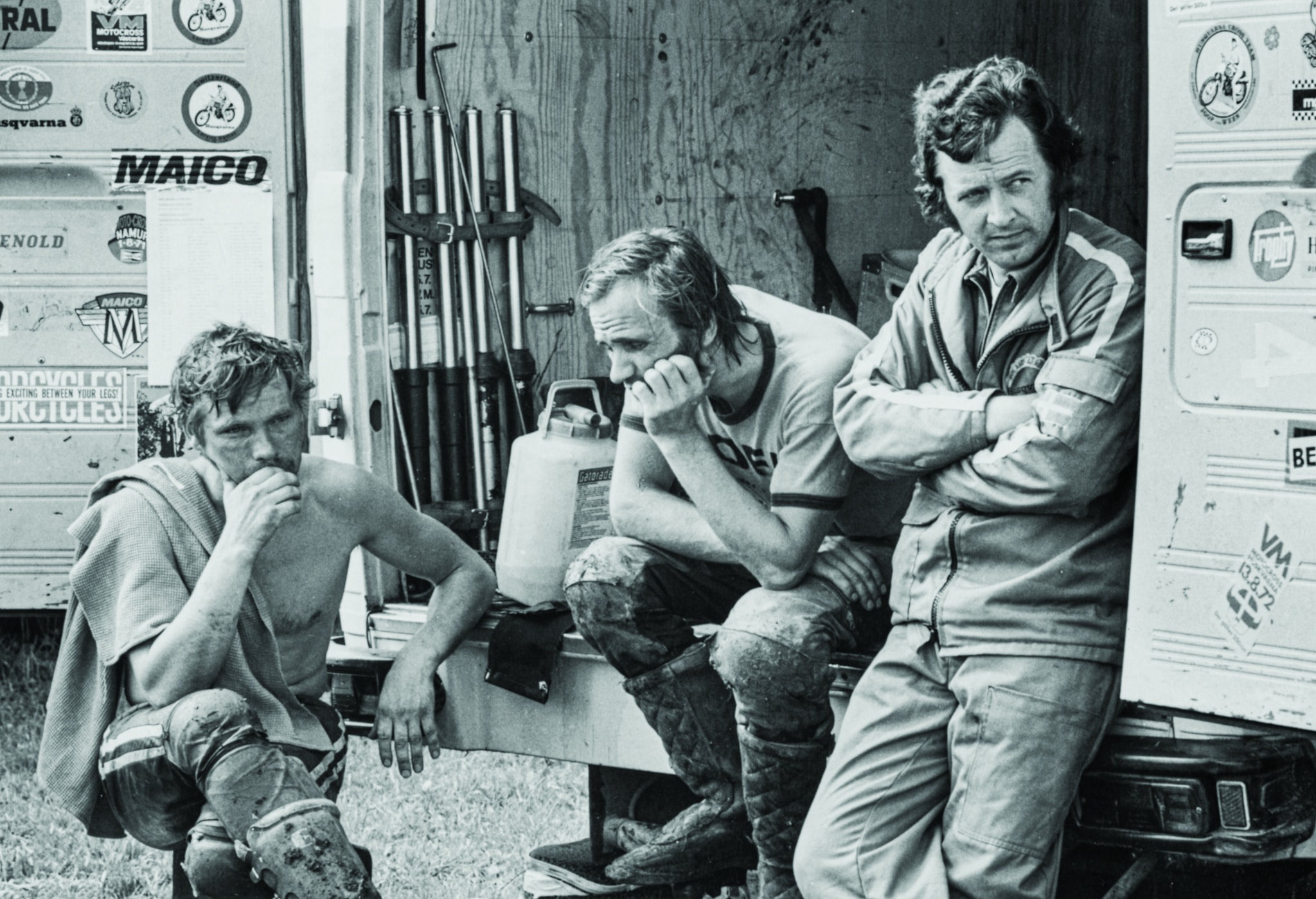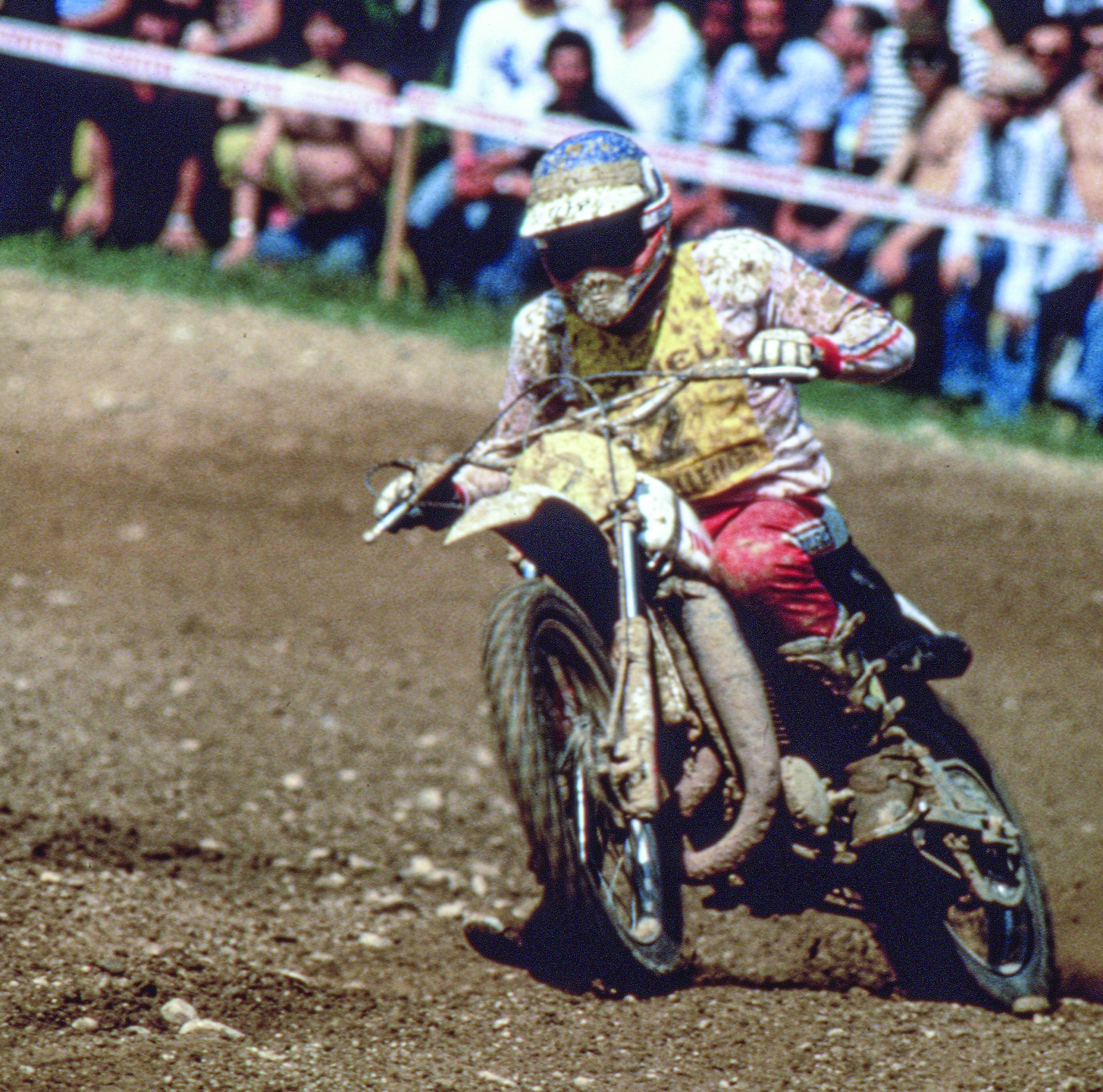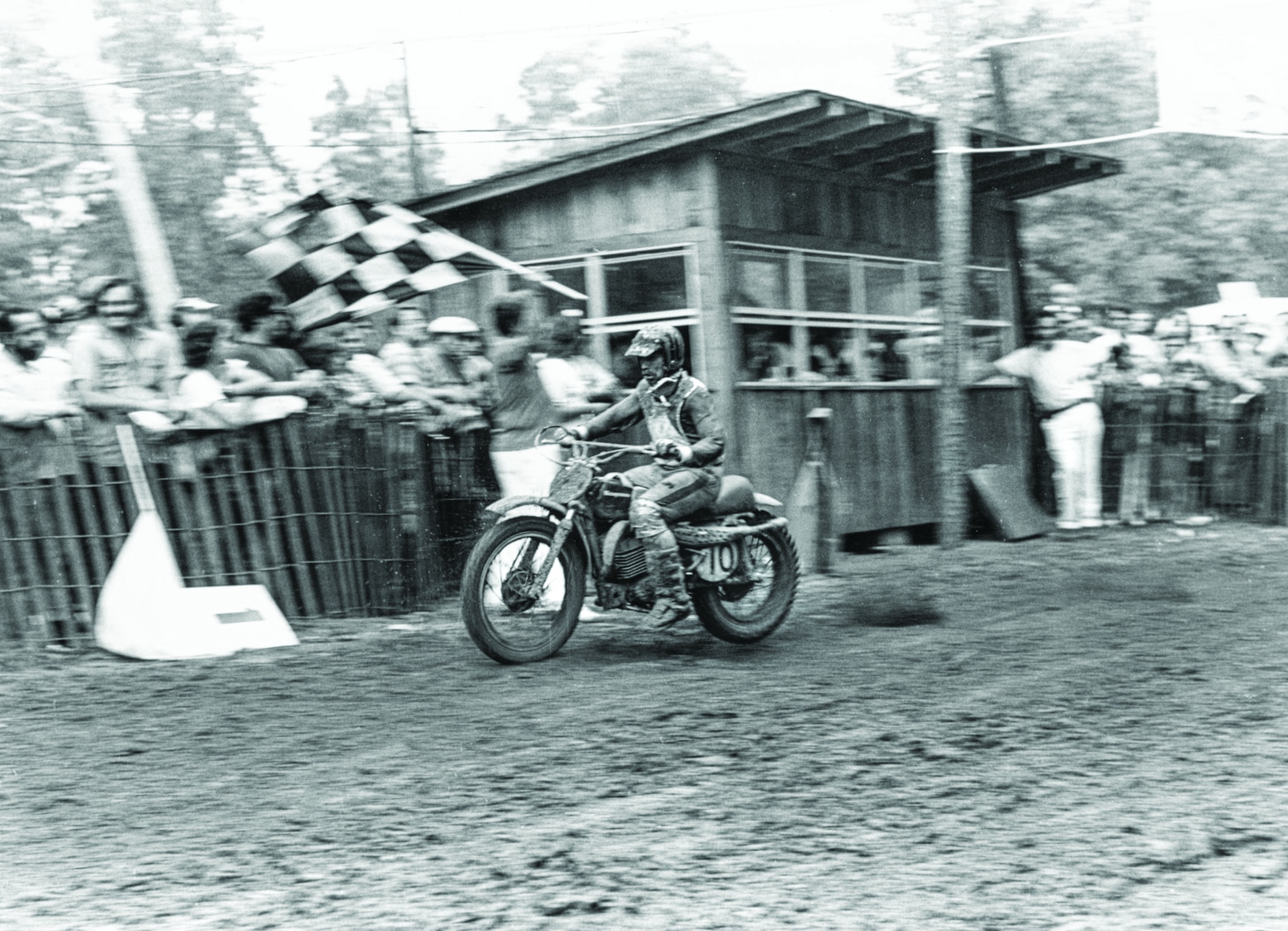MXA INTERVIEW: HEIKKI MIKKOLA THE MAN OF STEEL
HEIKKI, HOW DID YOUR INTEREST IN DIRT BIKES BEGIN? I started riding my friend’s motorcycle in the woods near my house. I rode three races on it, and after that I bought it for myself. It was a Greeves, and okay for off-road but not a true motocross bike. When I started motocross racing, Husqvarna made the best bike in the world at that time. Eventually, I was able to save some money, and then I sold the Greeves to buy a Husqvarna.
HOW DID MOTOCROSS DEVELOP FROM A HOBBY INTO RACING MORE SERIOUSLY? Even at my very first race, I did well and was happy with my riding. At the same time, I was involved in other sports also, but I had a feeling that motocross was the sport I was best at. My other sports were ski jumping, baseball and cross-country skiing.
WHEN DID YOU REALIZE THAT MOTOCROSS COULD BECOME YOUR PROFESSION? In the beginning, I only rode for fun. I only raced in Finland, but before long I was winning everything in my home country. I started thinking about racing the Grand Prix races that were close to Finland. I did that for a couple years before I decided I was ready to race the entire Grand Prix series.
DID HUSQVARNA MAKE YOU A FACTORY RIDER AND PAY YOU RIGHT AWAY? No. In my first couple years, I was driving myself to the Grand Prix races. The only money I got came from the prize money I won. In the beginning it was difficult, because I didn’t have much money. When I started competing in all the Grand Prix races, I started to do much better, and the factory saw the possibility of me being a World Champion.
YOU WERE RACING HUSKYS WHEN THE JAPANESE BRANDS SHOWED UP ON THE GRAND PRIX SCENE. WHAT WAS THAT LIKE? Around 1971 or 1972, the Japanese brands came into motocross. First, it was Suzuki, and they quickly signed the Belgian riders who were riding CZs, but Yamaha only signed one rider. That was Swedish rider Hakan Andersson. The Yamaha Monoshock was developed in 1972, and Andersson did very well on it; but, in 1973, it significantly improved, and on that bike Andersson was virtually unbeatable.
“IN THE BEGINNING, I ONLY RODE FOR FUN. I ONLY RACED IN FINLAND, BUT BEFORE LONG I WAS WINNING
EVERYTHING IN MY HOME COUNTRY.”
 Heikki Mikkola blasts by the beer garden at Namur.
Heikki Mikkola blasts by the beer garden at Namur.
WAS IT HARD TO ACCEPT LOSING TO ANDERSON’S YAMAHA MONOSHOCK? Yes, a little bit, but for the 1974 season, Husqvarna and Suzuki were working extra hard to be competitive. The new Husqvarna had moved-up rear shocks. So, with all of us being on more or less equal machinery, many times the motos would come down to the last two laps. While many of my competitors would be tired, I was not tired. It is true that my bike was not always the best, so I relied on my training in 1974, 1975 and 1976 before I signed with Yamaha, which was likely the best bike I ever raced.
LET’S RECAP YOUR EARLY YEARS. IN 1973, YOU WON THE 250 INTER-AM CHAMPIONSHIP. WHAT ARE YOUR MEMORIES OF THAT SERIES? I thought that was in 1971 (laughing). But yes, that was my first time spending time in America. The tracks were okay, and similar to Europe. We traveled everywhere by car. I think Supercross was coming on, but we never saw an actual race.
WHY DIDN’T YOU RACE THE BIGGER TRANS-AMA SERIES? I did race the Trans-AMA in 1971 and 1972, but the Inter-AMA series was in the summer, and the Trans-AMA was after the GP season in the fall. That was the time that I enjoyed hunting back home in Finland. Hunting was a big passion for me. By that time of the year, I had enough of motocross. I had given enough of my time to it.
1974 WAS A VERY BIG YEAR AS YOU BECAME THE 500cc WORLD CHAMPION. WHAT STANDS OUT FROM 1974? All the great competition, especially all the battles I had with Roger DeCoster. Roger was such a good competitor, fierce yet not a dirty rider.
“I HAD PROBLEMS WITH MY BIKE, PARTICULARLY WITH THE SHOCKS. I HAD ENGLISH GIRLING SHOCKS, AND THEY BROKE ALMOST
EVERY TIME. I WOULD BE WINNING, AND THEN NO SHOCKS ANYMORE.”

WHAT HAPPENED IN THE 1975 SEASON? I had problems with my bike, particularly with the shocks. I had English Girling shocks, and they broke almost every time. I would be winning, and then no shocks anymore. At many races, I was leading by a large margin, and at the 30-minute mark, Roger DeCoster would pass me because my shocks were blown. For the last three races, I bought Dutch-made Hulco shocks and started winning again, but it was too late for the Championship.
IN 1976 YOU MOVED TO THE 250 CLASS AND WON THE CHAMPIONSHIP! I got asked to move down to the 250 because Husqvarna said that they sold more 250s than the 500s, and it was better for business. Yes, I won the 250 World Championship, and it created a big marketing campaign for Husqvarna, as no one had ever won both the 250 and 500 World Championships. It was nice to win, but I would have preferred to stay in the 500 class.
WAS THAT WHEN THE JAPANESE BIKES IMPROVED MORE THAN THE EUROPEAN BIKES? Yes, certainly the progress was much better on the Japanese bikes. Yamaha asked me to sign with them for 1977, 1978 and 1979. I already knew that the Yamaha was a great motorcycle. Also, the Yamaha team was very professional, with many different engineers working there. For the 1977 season, Husqvarna was going to cut the racing budget. And Yamaha was very determined to teach Suzuki a lesson, so they put a lot into producing the best bike.
WAS IT A DRASTIC CHANGE FROM HUSKY TO YAMAHA? When I came to Yamaha and began testing the bikes for the first time, it was very different from with Husqvarna. At Husqvarna, we had one mechanic for five different riders, and at Yamaha it was the opposite; we had five mechanics for every rider. We had a mechanic for the engine, a mechanic for the suspension, a race mechanic and a practice mechanic.

WAS TEAM YAMAHA OPEN TO ACCEPTING YOUR SUGGESTIONS ON HOW TO IMPROVE THE BIKE? Yes. Every time we went riding, we tested the bike. The bike may not have ever been 100-percent perfect, but we constantly tried to make it better and better. And that was possible because I had so many people working together to improve it. If I told them that we should try something, they stayed up all night working on it.
IN 1977, YOU WON THE 500 WORLD CHAMPIONSHIP IN YOUR FIRST YEAR ON YAMAHA. Yes, it was very cool that I moved to Yamaha for 1977, but I want to point something out. At the very first 1977 Grand Prix in Austria, I was third place in the first moto. I asked the Yamaha team if they were okay that I finished third. After all, I was on a new bike. They said, “Hey, man, no; it is not okay to not win!” I went on to win the next six 500 GPs. DeCoster had been World Champion so many times, people believed that he could not make mistakes, but they were wrong.

IN 1978, YOU WERE THE 500 WORLD CHAMPION AGAIN AND NOBODY COULD BEAT YOU. In 1978, I was already a three-time World Champion. I had learned that to become the champion again I had to score at least 20 points in every race. That was my goal in 1978. My bike was great, and my physical conditioning was good.
YOU WON THE UNITED STATES GRAND PRIX ONCE. WHAT WAS THAT LIKE? I think I won one race at Carlsbad. I am not sure, but I think so. (Editor’s note: Heikki won the 1978 USGP.) It was Gerritt Wolsink who was so strong in Carlsbad. Many riders wanted to win Carlsbad, as it was televised on ABC, but that didn’t matter to me. I wanted to win every race! The Carlsbad GP was very difficult, as it was so hot. ABC had big problems with its television equipment, and before one of the motos we were on the starting gate for 45 minutes. It was so hot that our mechanics put ice cubes down the backs of our jerseys.
“IN 1978, I WAS ALREADY A THREE-TIME WORLD CHAMPION. I HAD LEARNED THAT TO BECOME THE CHAMPION
AGAIN I HAD TO SCORE AT LEAST 20 POINTS IN EVERY RACE.”
YOU FINISHED FIFTH IN THE 1979 500 WORLD CHAMPIONSHIP AND RETIRED. WHY? Well, in 1979, I was already 34 years old, and I was feeling that the sport was not for an old man like myself. It is for the young boys. I felt I was I not going to win any more World Championships. Maybe I could have been in the top five, but I only wanted to race to win.
YOU COULD HAVE STILL BEEN RACING, WINNING AND MAKING MONEY. Yamaha offered me a contract for 1980, but I didn’t sign it. Also, I broke my leg in the beginning of the 1979 season, and it was never the same. I was not 100 percent, and my leg was constantly hurting. My feeling was that my time was over. I just stopped. If I couldn’t win, I didn’t care. The money was not my motivation. Sometimes I think to myself, “Why did I stop so early?” But, then I tell myself, “It’s all right.”
YOU HELPED DEVELOP MOTOCROSS GEAR FOR SINISALO. DID YOU ENJOY THAT? Yes, Sinisalo was based in Finland, and they started to make motocross gear at the same time that I came into the sport. It was great being involved with Sinisalo. Later, John Gregory bought gear from Sinisalo under the JT Racing name, and I helped him, too. Basically, the entire time I was racing I was with Sinisalo. JT’s John Gregory was innovative, and when I came to America, I always met John. Later, the gear business changed, and JT Racing stopped having Sinisalo make its gear.
ISN’T THERE A CRAZY INCIDENT THAT HAPPENED WHEN YOU FIRST WORE SINISALO PANTS AT A GRAND PRIX? Yes, everyone raced in leather pants in the early days of motocross. Sinisalo was the first to introduce nylon pants. I first wore them in Belgium, and the race organizers said that I could not race with the pants because they were nylon pants. I said, “Okay, if I can’t race in nylon pants, then I do not race.” When the spectators heard that I wasn’t going to race, they wanted their money back. The organizers came to me and said, “Okay, you can ride this race wearing those pants, but not after this event.” After that, I wore them at every race!

“I WAS IN A CRASH WITH MANY OTHER RIDERS ON THE FIRST LAP. BY THE TIME I FOUND MY MOTORCYCLE, I WAS IN LAST PLACE. AT THE FINISH LINE, I WAS IN SECOND JUST BEHIND BRAD LACKEY, WHO WON THE MOTO.”
SPEAKING OF CRAZY INCIDENTS, DIDN’T A DOCTOR HAVE TO POP YOUR EYEBALLS OUT AT THE ITALIAN GP? Yes. At the 1974 Italian Grand Prix, my bike ran out of gas in the first moto, but I pushed it across the finish line and still finished second. So, in the second moto, near the end of the race, I stopped by the mechanics area to have them add enough gas so I could finish the moto. At this point in the race, I could not see very well with all the mud in my eyes, and then my mechanic accidentally splashed gasoline in my eyes. I won the second moto and the overall but went to see the track doctor immediately. He popped my eyeballs out and flushed them. Gerrit Wolsink had so much mud in his eyes that they transported him to the hospital.
NAME YOUR TOUGHEST COMPETITOR, FAVORITE YEAR AND MOST MEMORABLE RACE. There were many great riders back then, but Roger was always right there. My favorite year was 1978, of course. That year I was so much stronger than the other riders. But, it was also nice to take my first Grand Prix win in 1974, and then to win the 250 World Championship in 1976 with Husqvarna. The one race that stands out is the British 500 Grand Prix. I was in a crash with many other riders on the first lap. By the time I found my motorcycle, I was in last place. At the finish line, I was in second just behind Brad Lackey, who won the moto. One lap more and I believe that I would have won. That was a very good race.

AFTER YOUR RETIREMENT, YOU STAYED WITH YAMAHA TO HELP DANNY LAPORTE BECOME THE 1982 250 WORLD CHAMPION. Yes, my racer was Danny LaPorte. I really enjoyed my time with Danny, and he wanted to learn everything he could. He did awesome to win the World Championship. I was very proud of him. I worked for the Yamaha GP team for three years, but I stopped because my family needed me to run the family business. Now, at 75 years old, I am not working anymore. My son is taking care of my farming. I am only looking at the farm from the window [laughing]. I have a wonderful wife, along with my son and two daughters. I am enjoying my retirement with cross-country skiing and hunting. My knees aren’t as good as they used to be, but because of my hobbies, my fitness has stayed good.

HEIKKI, HOW IS MOTOCROSS IN FINLAND THESE DAYS? It is not very big. We have riders racing, but not as many great riders. The Finnish people do not have much interest in motocross anymore. Today there might be 200 people attending a Finnish race. When I raced, there were 10,000 people attending.
“THE SPORT HAS CHANGED; THE BIKES ARE BETTER; THE TRACKS AREN’T NATURAL ANYMORE; AND THE DIRT IS
VERY SMOOTH. BACK WHEN I WAS RACING, YOU HAD TO BE MADE OF STEEL.”
DO YOU FOLLOW MOTOCROSS OR SUPERCROSS THESE DAYS? It is difficult to follow motocross in Finland. There are not many GPs held here any longer. I could watch the Grands Prix on the television, but I would rather be outside than inside watching television. The sport has changed; the bikes are better; the tracks aren’t natural anymore; and the dirt is very smooth. Back when I was racing, you had to be made of steel.
THEY CALLED YOU “THE FIERCE FINN” AND “THE FLYING FINN,” WHICH NICKNAME DID YOU PREFER? I liked “The Flying Finn,” but whatever made other people happy was okay by me. My friends called me “Hessu.”

AS ONE OF THE LEGENDS, HOW DO YOU WANT TO BE REMEMBERED IN MOTOCROSS? I loved motocross! I devoted my life to motocross. I won Championships, but I never got into the parties, women or expensive car scene. I do want to tell one story from the final 1974 GP in Luxembourg. Roger DeCoster was leading the race, but his bike broke near the end of the moto. At that moment, I became the World Champion. In the paddock, Roger was there to greet me with a bottle of champagne. We drank it together. That may be my favorite memory!






Comments are closed.